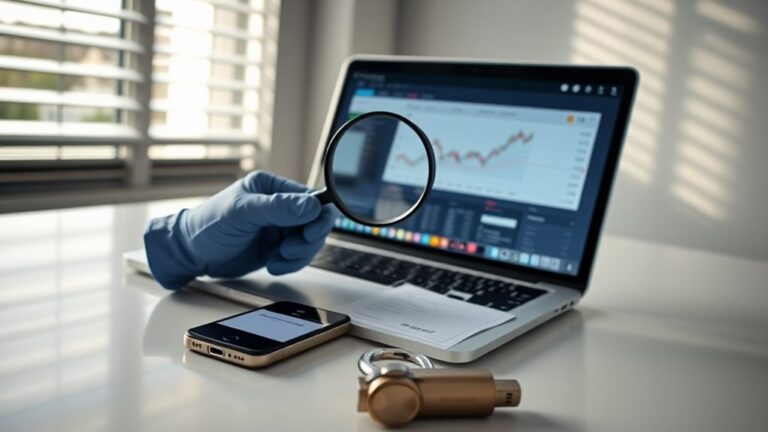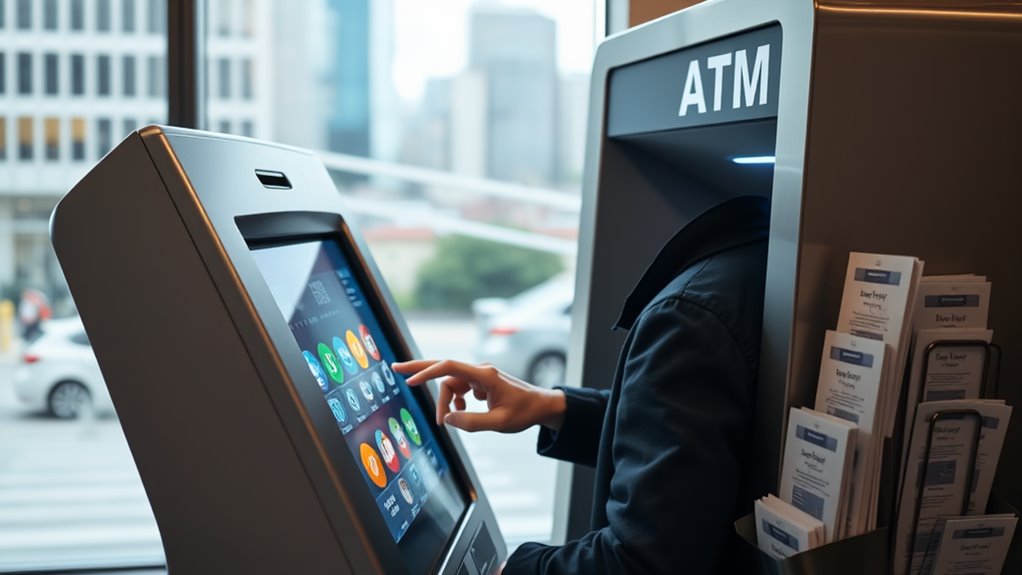
How to Use a Crypto ATM to Buy or Sell Crypto: Essential Guide
To use a crypto ATM to buy or sell cryptocurrencies, individuals must first locate a suitable machine using tools like Coin ATM Radar and guarantee they have a secure digital wallet. Transactions begin by selecting either the buy or sell option, followed by verifying identity through methods like SMS or ID scans. Users then scan their wallet's QR code to receive or send the specified cryptocurrency amount. Fees, often ranging from 7% to 12%, apply to each transaction. For a deeper understanding, further exploration of ATM functionalities and security measures is recommended.
Key Takeaways
- Use Coin ATM Radar or operator websites to find a nearby crypto ATM with desired functionalities.
- Choose the appropriate transaction on the ATM, either buy or sell, and follow the on-screen instructions.
- For purchasing, scan your wallet's QR code at the ATM after selecting how much cryptocurrency you want to buy.
- For selling, transfer crypto from your digital wallet to the ATM, verify the transaction on your phone, and withdraw cash once confirmed.
- Always verify transaction details and fees on the ATM screen, and keep the receipt for future reference.
Understanding the Basics of a Crypto ATM
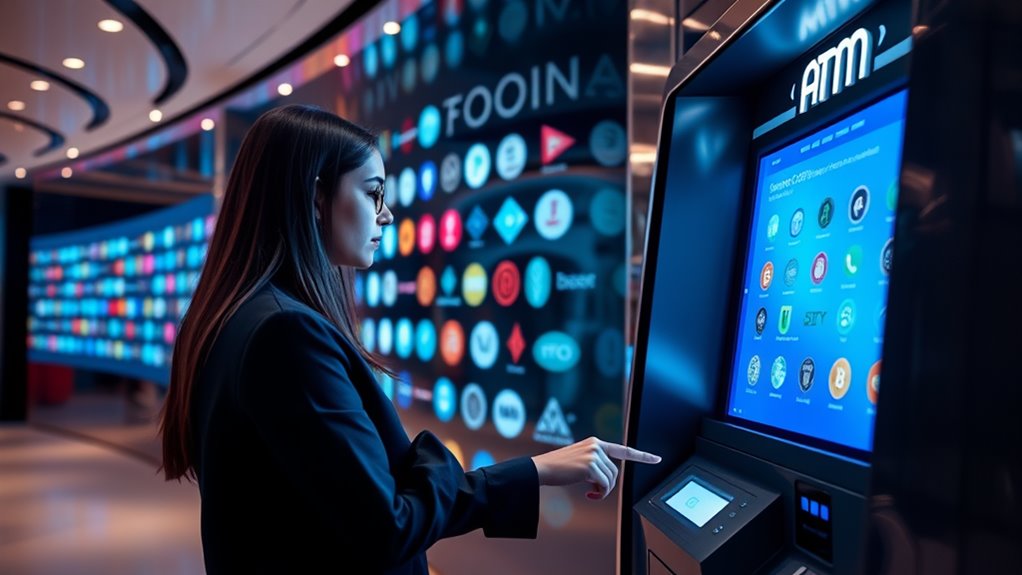
A crypto ATM is a specialized kiosk designed for the transaction of cryptocurrencies such as Bitcoin. These machines allow users to buy and sell digital currencies, linking directly to various cryptocurrency exchanges and blockchain networks for transaction processing.
Unlike traditional banking transactions, crypto ATMs require users to have a digital wallet, as they do not process transactions through a conventional bank account. Depending on their design, these ATMs can support either one-way (buy only) or two-way (buy and sell) operations.
Recognizable providers like Coinme and Coinhub have established extensive networks of these ATMs, highlighting their growing footprint in the financial landscape of digital currencies. This technology represents a pivotal shift in how individuals interact with digital assets.
Locating a Nearby Crypto ATM
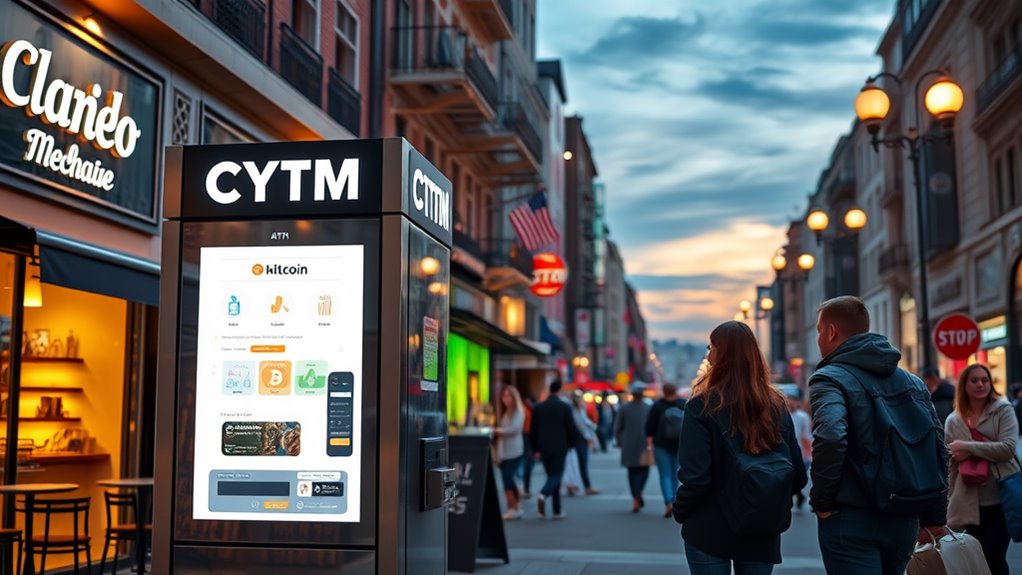
Where can one find a nearby crypto ATM? Those looking to engage with cryptocurrencies directly can utilize various tools to locate Bitcoin ATMs.
Websites such as Coin ATM Radar leverage detailed maps and geolocation services, guiding users to ATMs based on their current location within a predefined radius.
For more personalized assistance, prominent operators like General Bytes and Byte Federal provide extensive lists of their machines, which are strategically placed in accessible public spots like grocery stores, pharmacies, and shopping malls.
Additionally, these locators offer real-time updates, detailed information about each machine's capabilities, including supported cryptocurrencies, and navigation aid making it convenient and straightforward for anyone to find a nearby crypto ATM.
Preparing for Your Transaction
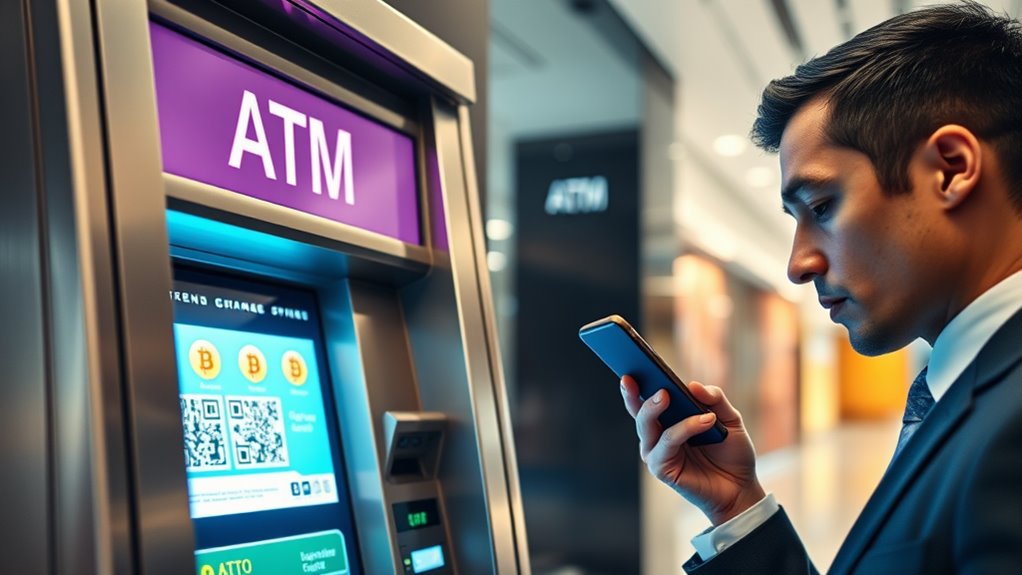
Before using a crypto ATM, it's vital to select a suitable wallet tailored to the specific needs and security features of the user. Verifying identification requirements is also important, as these vary depending on transaction volumes and local regulations. A thorough preparation guarantees a smoother transaction process at the crypto ATM, minimizing potential issues and delays. Moreover, understanding the fee structures of the ATM is crucial as they can vary significantly and affect the total cost of the transaction.
Select Suitable Wallet
How does one select the most suitable wallet for using a crypto ATM? When preparing for transactions at a crypto ATM, considering wallet types is essential.
Mobile wallets on smartphones offer unparalleled convenience and ease of use for on-the-go transactions. Desktop wallets installed on personal computers provide enhanced security for those preferring less frequent, but larger transactions.
For maximum security, hardware wallets, which store cryptocurrencies offline, are advisable. When choosing a wallet, prioritize strong security features such as encryption and two-factor authentication, guarantee compatibility with your cryptocurrency, and seek wallets with intuitive user interfaces.
Also, important is selecting a wallet that manages private keys securely and offers reliable customer support. Finally, a capable wallet should facilitate easy generation of QR codes and provide straightforward transaction monitoring.
Some popular options include Ledger and Trezor, which are hardware wallets known for their robust security measures and support for multiple cryptocurrencies.
Verify Identification Requirements
When preparing to use a crypto ATM, it is crucial to verify your identity according to the kiosk's specific requirements. Commonly accepted forms include government-issued IDs like passports, driver's licenses, and state IDs. Some machines use advanced scanners to digitize these documents directly.
Depending on the transaction amount, different levels of identification might be required. For smaller transactions, basic information such as name, date of birth, and phone number may suffice. However, for larger sums, a more thorough verification involving photo IDs and possibly additional information like social security numbers is necessary.
Always consider the operator's adherence to KYC and AML regulations, which help guarantee the security and legality of transactions.
Initiating a Purchase at a Crypto ATM
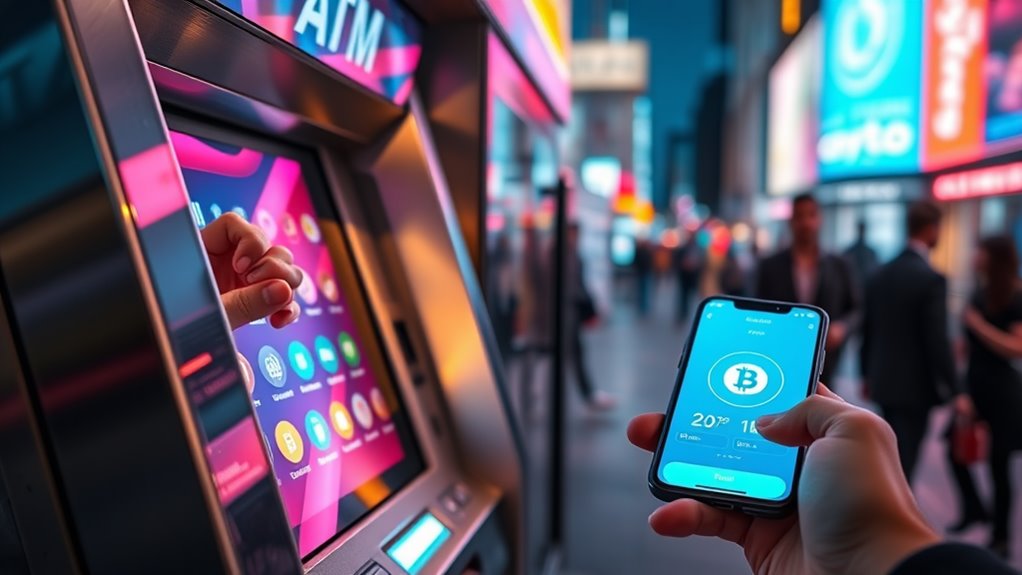
Initiating a purchase at a crypto ATM involves several clearly defined steps that begin the moment a user approaches the machine.
First, locating a crypto ATM is essential, achieved by using tools like CoinATMRadar. Upon finding a machine, users select the "Buy Bitcoin" option on the ATM's user-friendly interface.
The next step is verification, often requiring the user to enter a phone number to receive a verification code.
Having a Bitcoin wallet is necessary, as the user must scan their wallet's QR code to direct the purchased cryptocurrency to the correct address.
Additionally, users need to be aware of the high transaction fees, which can range from 7% to 20%.
Completing a Sale of Cryptocurrency
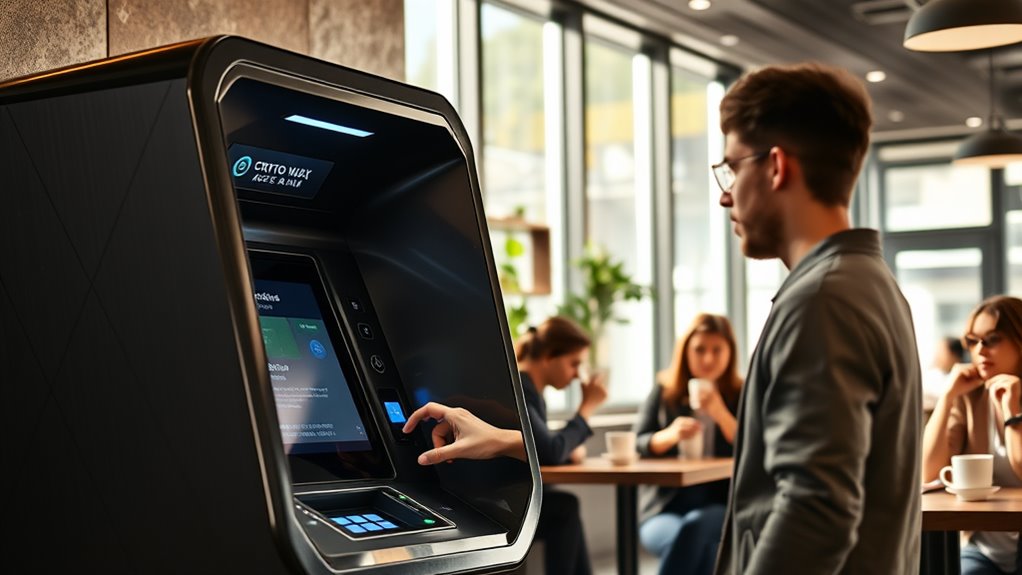
When completing a sale of cryptocurrency at a crypto ATM, the user must first initiate the transaction, selecting the type of cryptocurrency to sell and the amount they wish to convert into cash.
The process involves sending the specified cryptocurrency from the user's wallet to the ATM, which necessitates a careful transfer to match the ATM's requested amount exactly.
Once the transaction is validated on the blockchain, the user can then proceed to withdraw cash, typically after receiving a confirmation via text or directly through the ATM interface.
Initiating Crypto Sale
To begin the process of selling cryptocurrency using a Crypto ATM, users first need to locate an ATM that supports such transactions.
The steps involved in initiating a crypto sale are essential and must be followed carefully to guarantee a smooth and secure transaction:
- Selecting an ATM: Identify the right ATM using markers on locator maps, confirming it supports both buying and selling of cryptocurrencies like BTC, LTC, and ETH.
- Verifying Transaction Capacity: Understand the specific ATM's transaction limits and verify it accommodates the amount you wish to sell.
- Understanding Security Measures: Due to the non-reversible nature of crypto transactions, confirm all steps carefully to avoid potential fraud.
Sending Crypto to ATM
Completing a sale of cryptocurrency at a Crypto ATM begins with sending the appropriate amount of crypto from your digital wallet to the machine.
Users initiate this process by selecting the "Sell" option on the ATM and entering the desired transaction amount. The ATM then displays a QR code, which the user scans using their digital wallet app.
It is essential to send the exact amount specified by the ATM to guarantee transaction accuracy. After scanning, users must confirm the transaction amount within their digital wallet and proceed to send the cryptocurrency.
The ATM will verify the transaction on the blockchain, which may take several minutes, assuring the security and accuracy of the transfer.
Receiving Withdrawal Cash
After the cryptocurrency transaction is successfully verified by the Crypto ATM, the process moves to the vital stage of cash withdrawal. Users proceed through the following steps:
- Confirmation and Notification: The ATM verifies blockchain confirmation, then signals readiness. Often, users receive a text message confirming that funds are available.
- Selection for Redemption: Users must select the "Redeem" option on the ATM interface to initiate the cash dispensing sequence.
- Secure Cash Dispensing: The ATM conducts redundancy checks to guarantee the correct amount is dispensed. Advanced security features, such as encryption and KYC/AML compliance, safeguard the transaction.
Finally, customers should obtain and securely store their receipt, which is essential for any post-transaction queries or discrepancies.
Necessary Steps for Large Transactions
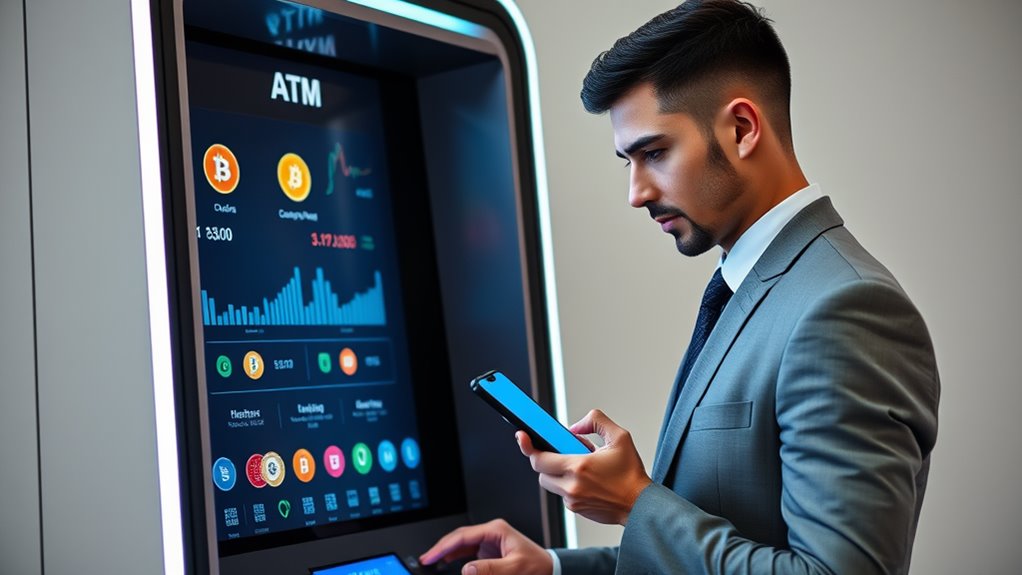
Engaging in large transactions at a Bitcoin ATM necessitates a thoughtful approach due to the implications and requirements involved.
Prior to initiating a large transaction, users must familiarize themselves with the daily and minimum limits imposed by the ATM, which vary by operator and may range from $3,000 to $10,000.
Understanding the machine's identity verification process is vital, as transactions above a certain threshold often require additional security checks, such as identity verification (KYC).
Highlighting the importance of the machine's identity verification process is crucial for secure, large-scale Bitcoin ATM transactions.
Additionally, users should confirm the transaction amount on the ATM screen and double-check their crypto wallet address to avoid mistakes.
Finally, verifying the ATM's cryptocurrency acceptance and ensuring it supports the desired transaction type is essential for a successful large-scale operation.
Interacting With the ATM Interface
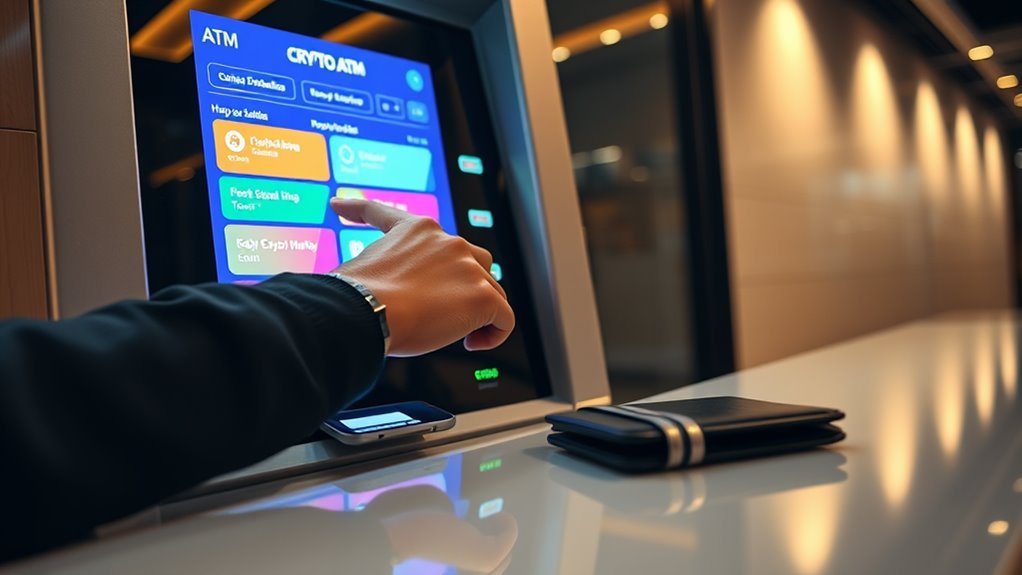
When interacting with a crypto ATM, users must navigate the touchscreen menus to initiate transactions such as buying or selling cryptocurrencies.
It's important to follow on-screen instructions carefully and be prepared to handle any errors that might arise during the process, such as mistyped wallet addresses or incorrect transaction amounts.
Clear prompts and error handling tips are typically provided to guide users smoothly through each step.
Navigating Touchscreen Menus
Why is interface navigation critical at a crypto ATM? Smooth and intuitive interaction with the ATM's touchscreen guarantees a successful transaction.
Users face various options and steps that must be executed with precision to avoid errors in buying or selling cryptocurrencies.
Here's what typically happens during the navigation process:
- Transaction Type Selection: Users start by choosing either the buy or sell option, depending on their needs.
- Input of Transaction Details: The ATM requires users to enter specific details such as the amount of cryptocurrency they wish to transact.
- Verification and Confirmation: Essential security measures like phone number verification and ID checks are conducted to comply with regulations and maintain transaction security.
Navigating these menus correctly is crucial for a seamless and secure crypto transaction.
Error Handling Tips
Although interacting with a cryptocurrency ATM is generally straightforward, encountering technical issues can occasionally complicate transactions. If the ATM screen freezes or displays an error message, users should restart the transaction process immediately.
Should problems persist, contacting customer support with details like error codes, transaction ID, time, and ATM location is essential. Different providers may have varied troubleshooting procedures, and the operator's website can offer specific guidelines.
Effective communication with support involves clear descriptions of each step taken before the error occurred. Additionally, users should understand that transaction delays might happen due to heavy blockchain network traffic, requiring patience and possibly contacting the operator if delays seem excessive.
Securing Your Transaction and Privacy
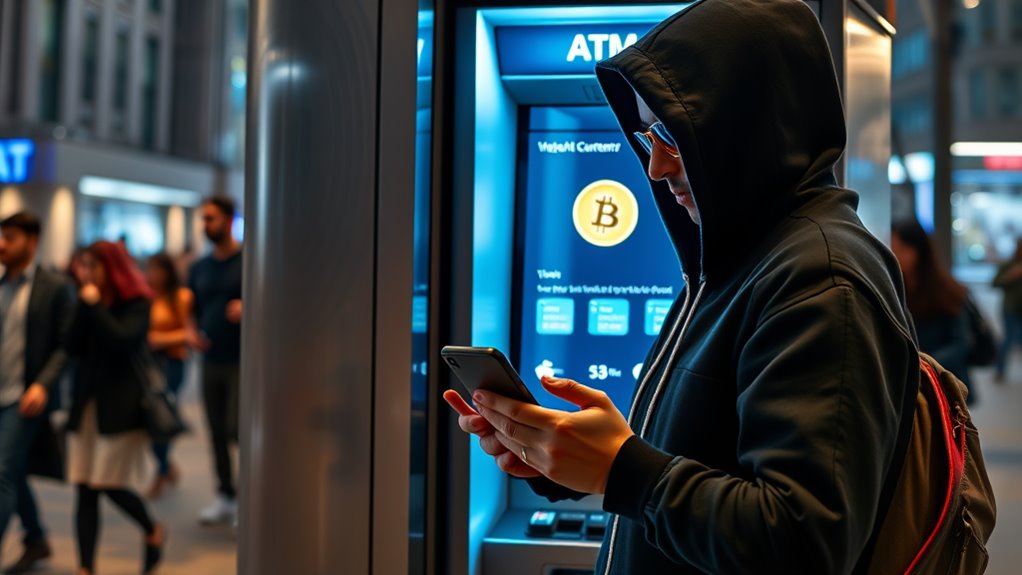
Securing both the transaction and the privacy of users is paramount when using a crypto ATM. Here are essential steps to guarantee that transactions are safe and private:
- Data Encryption and ID Verification: Cryptocurrency ATMs use advanced encryption to protect data transmission and require identity verification through methods such as SMS, government-issued IDs, or biometric data, maintaining compliance and security.
- Continuous Monitoring and Secure Software: ATMs are equipped for real-time monitoring of suspicious activities and utilize securely updated software to guard against potential cyber threats.
- Robust Physical Security and Minimal Information Storage: The machines are often installed in secure locations and designed to store minimal personal information, reducing the risk for both physical and digital breaches.
Using multi-signature protection can also add a crucial layer of security to your transactions at cryptocurrency ATMs, ensuring that multiple verifications are needed for each transaction to help ward off unauthorized access.
Addressing Common Errors and Issues
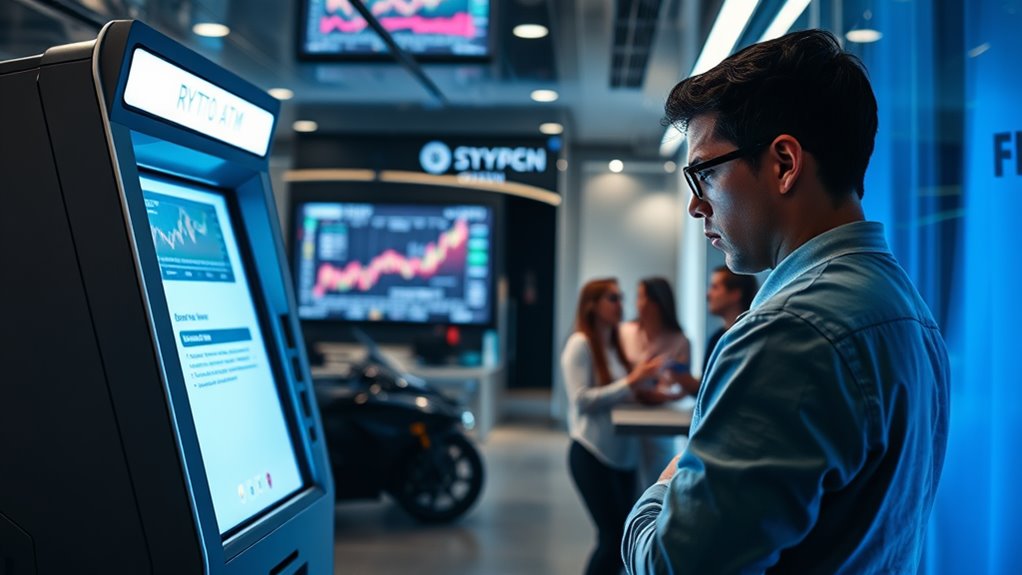
When using a crypto ATM, users often encounter several common errors and issues that can disrupt the transaction process.
One frequent mistake is entering the incorrect wallet address; always double-check characters, especially the first and last, to prevent permanent loss of funds. Using QR code scanning minimizes errors.
Verifying the ATM's operating hours and its cash-only policy are vital steps; many are located in shops that do not operate 24/7.
Transaction delays are common due to blockchain confirmations, necessitating patient waiting for completion.
For any technical or verification problems, having the receipt and contacting the provider are significant steps.
Always exercise caution to avoid QR code-related scams.
Evaluating Fees and Transaction Limits
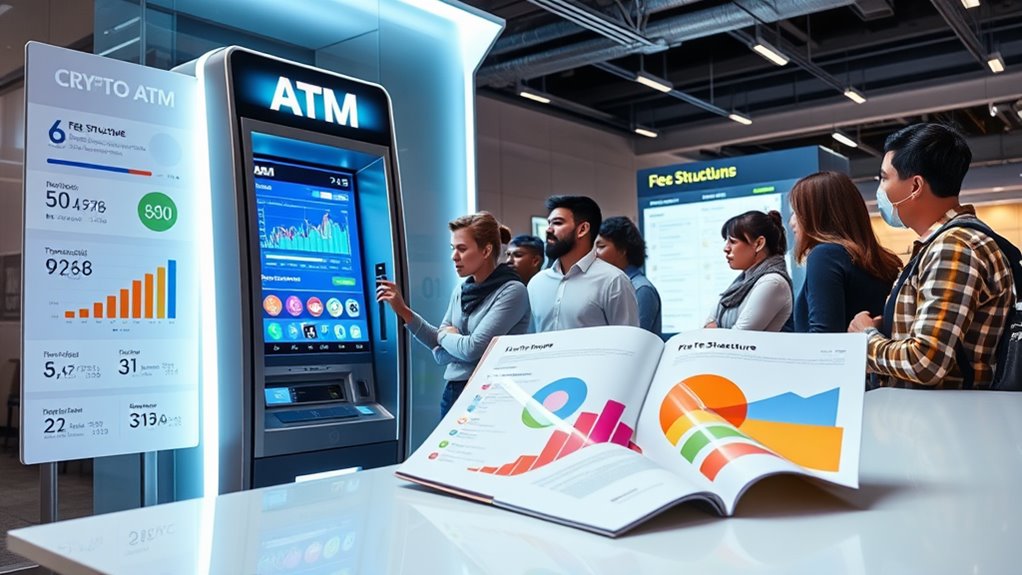
Why should one consider the fees and transaction limits of a crypto ATM? Understanding these aspects is essential, as they directly affect the cost and accessibility of transactions.
Considering fees and transaction limits at crypto ATMs is crucial for cost-effective and accessible transactions.
Here are key considerations:
- Transaction fees: Typical charges range from 7% to 12%. Checking fee structures across different providers is important to minimize costs.
- Network fees: Additional fees from $1 to $3 may apply depending on the blockchain network used, influencing the overall expenditure.
- Transaction limits: Limits can vary dramatically, from daily allowances of $3,000 up to monthly ceilings like $99,999. Knowing these limits is important for planning substantial transactions or regular trading activities.
Frequently Asked Questions
How Reliable Are Crypto ATM Exchange Rates Compared to Online Exchanges?
Crypto ATM exchange rates are often less favorable and less transparent compared to online exchanges. They are subject to market volatility, potentially leading to discrepancies in value received during transactions at these machines.
Can I Use a Foreign Currency at a Crypto ATM?
Crypto ATMs typically do not accept foreign currencies directly; they operate with local fiat currencies. Users looking to use foreign currency must first convert it to the local currency before interacting with the ATM.
What Happens if a Crypto ATM Malfunctions During My Transaction?
When a crypto ATM malfunctions during a transaction, users may face delayed or incomplete transactions. Contacting support and documenting transaction details are critical for resolving issues and potentially recovering lost funds.
Are There Specific Times When Crypto ATMS Are Offline for Maintenance?
Crypto ATMs may be offline for maintenance during pre-scheduled, off-peak hours, varying by operator. Users should check the operator's notifications for specific times to avoid inconvenience and guarantee transaction availability.
How Often Do Crypto ATM Networks Update Their Supported Cryptocurrencies?
Crypto ATM networks frequently update supported cryptocurrencies, typically aligning with market demands and regional preferences. Updates vary but can be bi-monthly, ensuring compatibility with new cryptocurrencies and maintaining functionality through open APIs.
Conclusion
Maneuvering the digital labyrinth of crypto ATMs requires both knowledge and caution. As explorers in this electronic expanse, users should arm themselves with understanding, tread carefully through the transactional grounds, and keep vigilant over their digital footprints. Familiarity with the machine's interface, awareness of security protocols, and preparedness for potential errors are essential. Just as the prudent mariner respects the sea, so too must crypto traders respect the intricate ebb and flow of cryptocurrency exchanges.




